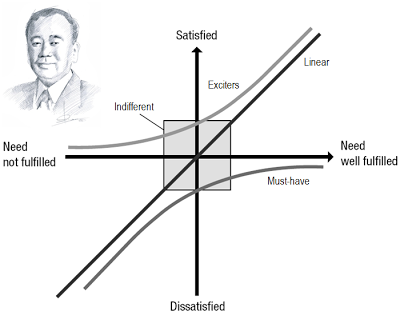Role-Based Project Management Software
Agile Case Study (4/5): Release Planning
May 25, 2021

Fourth post on the chapter 23 of the book Agile Estimating and Planning, by Mike Cohn. In the previous post the Havannah team met with on this agenda:
- First sprint planning.
- Market research outcomes review.
- Initial estimate for the release plan and the project schedule.
First point was completed with the team firm commitment to complete 4 stories of 18 points. Now they cover the 2 other points, meaning they need to prioritize the rest of the stories. One way to do this is by following the model by professor Noriaki Kano:

Kano model is a technique to determine if some product features are mandatory (users will be not satisfied if not delivered), linear (the more features delivered, the more satisfaction) or exciters (users are satisfied if delivered but they don’t complain if not). The process to get these outcomes is to make users answer a survey with functional questions (how they feel if feature is included) and dysfunctional questions ( how they feel if feature is NOT included ). There is a mapping table to classify answers under 6 categories: mandatory, linear, exciter, contrary, questionable, indifferent.

Now we can read what happens during the second part of the meeting. They estimate the project will take 7 iterations (14 weeks). Why? Because at a velocity of 18 points per iteration, in 7 iterations they will complete the 132 story points in the release (not the total of 146). The Product Owner get rid of stories considered as indifferent (6 points) and not all exciter stories should be included firs (8 points). The team has an estimate for the project duration, but the coach warns them not to publish an exact deadline. The should say the project will take between 12 and 20 weeks.
Release Planning
When everyone returned and was seated around the table, Frank began the meeting, “Delaney, tell us about the product research and what you found.”



- As a player, I can start a new game (1)
- As a player, I can restore a saved game (2)
- As a player, I want the computer to recognize a winning shape (2)
- As a player, I want to place a piece on the board using either my keyboard or my mouse (3)
- As a player, I want to see a visual indicator of whose turn it is (2)
- As a player, I’d like a visual indicator of the last piece played (make it blink perhaps) (2)
- As a player, I’d like to undo and redo moves (2)
- As a player, I’d like to be able to save games (3)
- As a player, I want to be able to quit the game (1)
- As a player, I want to restart the game so that I can give up and start over (1)
- As a player, I’d like the computer to play a move in no more than 2 seconds on a 2.0Ghz PC (8)
- As a player, I’d like to step forward through moves so that I can review a game I’ve already played (5)
- As a player, I can select the computer’s playing strength (1)
- As a player, I can play against a weak engine that recognizes rings (8)
- As a player, I can play against a weak engine that recognizes bridges (5)
- As a player, I can play against a weak engine that recognizes forks (8)
- As a player, I can play against a medium-strength engine (8)
- As a player, I can play against a strong engine (20)
- As a player, I’d like to be able to use the system to play against another human on my computer (3)
- As a player, I want all pieces of the winning shape to blink or glow so that I can see the winning shape (3)

- As a player, I want a nice looking splash screen when the program starts (5)
- As a player, I want nice looking background art that integrates with the game boards (5)
- As a player, I’d like to be able to choose between a wooden board and pieces and a metal board and pieces (8)
- As a player, I want the system to play background music (5)
- As a player, I can select the background music played by the system (1)
- As a new player, I want access to an online help system (8)

- As a player, I’d like to ask for a hint sometimes (1)
- As a new player, I want to be able to view an interactive tutorial for the game (8)
- As a new player, I’d like to be warned after making a horrible move and be given the chance to take it back (8)
- As a new player, when it’s my turn to play I’d like to be shown any hex I should play in because if I don’t the computer will play there next and win (3)

- As a player, I want the system to keep track of how many games I win and lose. (By the playing strength of the computer?) (3)
- As a player, I’d like to add annotations to saved games (3)


.jpg)

- As a player, I can play against a weak engine that recognizes rings (8)
- As a player, I can play against a weak engine that recognizes bridges (5)
- As a player, I want the computer to recognize a winning shape (2)
- As a player, I’d like to be able to use the system to play against another human on my computer (3)



